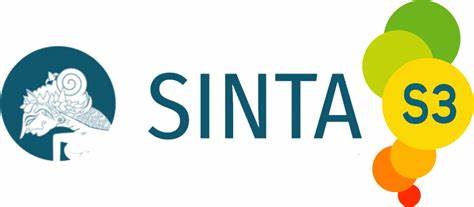STUDENTS’ PERCEPTION OF USING “LEARN & SPEAK ENGLISH PRAKTIKA” IN IMPROVING SPEAKING SKILLS
PERSEPSI SISWA MENGGUNAAN APLIKASI "LEARN & SPEAK ENGLISH PRAKTIKA" SEBAGAI MEDIA DALAM MENINGKATKAN KEMAMPUAN BERBICARA
Keywords:
persepsi siswa, kemampuan berbicara, pembelajaran berbasis AI, Learn & Speak English Praktika, teknologi pembelajaran bahasaAbstract
This study aims to analyze students' perceptions towards the use of the Learn & Speak English Praktika application in improving English speaking skills. The main focus of this study is how this application helps students improve their pronunciation, motivation, confidence, and vocabulary. This study uses a qualitative method with data collection through questionnaires and interviews with grade XI students in Medan. The results showed that the majority of students gave a positive response to this application. They felt that the real-time feedback feature helped improve pronunciation, AI-based interactions increased confidence, and the variety of conversation topics encouraged motivation and enriched their vocabulary. The implications of this study indicate that AI-based technology can be an effective alternative in language learning, especially in improving speaking skills. This application can be utilized by educators as an additional learning media that increases student engagement and independence in learning English. However, this study has several limitations, such as the limited duration of the study and the sample coverage which only included one school. Therefore, further research is recommended to examine the long-term impact of this application and compare it with conventional learning methods in a broader context.
References
Abdulmunem, R. A. (2023). Artificial intelligence in education. In Comparative Research on Diversity in Virtual Learning: Eastern vs. Western Perspectives (pp. 241-255). IGI Global. https://doi.org/10.4018/978-1-6684-3595-3.ch012
Abimanto, D., & Sumarsono, W. (2024). Improving English Pronunciation with AI Speech-Recognition Technology. Acitya: Journal of Teaching and Education, 6(1), 146–156. https://doi.org/10.30650/ajte.v6i1.3810
Aini, N., Amalia, F., & Ningrum, A. S. B. (2022). Improving Students’ Speaking Skill Using Hello English Application as a Medium of Learning from Home. IDEAS: Journal on English Language Teaching and Learning, Linguistics and Literature, 10(1), 730–745. https://doi.org/10.24256/ideas.v10i1.2533
Anggraini, A. (2022). Improving students' pronunciation skill using ELSA Speak application. Journey, 5(1), 135-141.
Baxter, P., & Jack, S. (2008). Qualitative Case Study Methodology: Study Design and Implementation for Novice Researchers. The Qualitative Report, 13(4), 544–559. https://doi.org/10.46743/2160-3715/2008.1573
Boffi Canepa, A. (2013). Teaching Speaking: A Holistic Approach. ELT Journal, 67(4), 505–507. https://doi.org/10.1093/elt/cct051
Clark, R. C., & Mayer, R. E. (2023). E-learning and the science of instruction: Proven guidelines for consumers and designers of multimedia learning. John Wiley & sons.
Ding, N., Wang, Y., & Wang, Y. (2025). English as a foreign language teacher’s well-being, resilience, and burnout. Porta Linguarum Revista Interuniversitaria de Didáctica de Las Lenguas Extranjeras, 43, 147–166. https://doi.org/10.30827/portalin.vi43.28350
Fink, M. C., Robinson, S. A., & Ertl, B. (2024, July). AI-based avatars are changing the way we learn and teach: benefits and challenges. In Frontiers in Education (Vol. 9, p. 1416307). Frontiers Media SA.https://doi.org/10.3389/feduc.2024.1416307
Godwin-Jones, R. (2021). Big Data and Language Learning: Opportunities and Challenges. Language Learning and Technology, 25(1), 4–19.
Krashen, S. (1982). Principles and practice in second language acquisition.
Loewen, S., Crowther, D., Isbell, D. R., Kim, K. M., Maloney, J., Miller, Z. F., & Rawal, H. (2019). Mobile-assisted language learning: A Duolingo case study. ReCALL, 31(3), 293–311. https://doi.org/10.1017/S0958344019000065
Nizar, M. A. (2024). Semantic Analysis of The Use Of English Abbreviation In Instagram Captions (Doctoral dissertation, UIN Raden Intan Lampung). http://repository.radenintan.ac.id/32958/
Nowell, L. S., Norris, J. M., White, D. E., & Moules, N. J. (2017). Thematic Analysis: Striving to Meet the Trustworthiness Criteria. International Journal of Qualitative Methods, 16(1). https://doi.org/10.1177/1609406917733847
Richards, J. C. (2008). Teaching listening and speaking (Vol. 35). Cambridge, England: Cambridge university press.
Shahzad, M. F., Xu, S., Lim, W. M., Yang, X., & Khan, Q. R. (2024). Artificial intelligence and social media on academic performance and mental well-being: Student perceptions of positive impact in the age of smart learning. Heliyon, 10(8). https://doi.org/10.1016/j.heliyon.2024.e29523
Sporn, Z., Chanter, J., & Meehan, D. (2020). Babbel Language Learning Podcasts. International Journal of Advanced Corporate Learning (IJAC), 13(3), 43. https://doi.org/10.3991/ijac.v13i3.17025
Zamiri, M., & Esmaeili, A. (2024). Methods and Technologies for Supporting Knowledge Sharing within Learning Communities: A Systematic Literature Review. Administrative Sciences, 14(1). https://doi.org/10.3390/admsci14010017
Downloads
Published
Issue
Section
License

This work is licensed under a Creative Commons Attribution-ShareAlike 4.0 International License.
The author is responsible for acquiring the permission(s) to reproduce any copyrighted figures, tables, data, or text that are being used in the submitted paper. Authors should note that text quotations of more than 250 words from a published or copyrighted work will require grant of permission from the original publisher to reprint. The written permission letter(s) must be submitted together with the manuscript.




